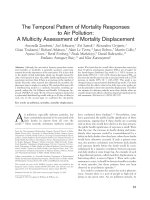Raspberry pi robotic blueprints utilize the powerful ingredients of raspberry pi to bring to life your amazing robots that can act, draw, and have fun with laser tags ( TQL)
Bạn đang xem bản rút gọn của tài liệu. Xem và tải ngay bản đầy đủ của tài liệu tại đây (10.03 MB, 198 trang )
[1]
www.it-ebooks.info
Raspberry Pi Robotic Blueprints
Utilize the powerful ingredients of Raspberry Pi to bring
to life amazing robots that can act, draw, and have fun
with laser tag
Richard Grimmett
BIRMINGHAM - MUMBAI
www.it-ebooks.info
Raspberry Pi Robotic Blueprints
Copyright © 2015 Packt Publishing
All rights reserved. No part of this book may be reproduced, stored in a retrieval
system, or transmitted in any form or by any means, without the prior written
permission of the publisher, except in the case of brief quotations embedded in
critical articles or reviews.
Every effort has been made in the preparation of this book to ensure the accuracy
of the information presented. However, the information contained in this book is
sold without warranty, either express or implied. Neither the author, nor Packt
Publishing, and its dealers and distributors will be held liable for any damages
caused or alleged to be caused directly or indirectly by this book.
Packt Publishing has endeavored to provide trademark information about all of the
companies and products mentioned in this book by the appropriate use of capitals.
However, Packt Publishing cannot guarantee the accuracy of this information.
First published: October 2015
Production reference: 1261015
Published by Packt Publishing Ltd.
Livery Place
35 Livery Street
Birmingham B3 2PB, UK.
ISBN 978-1-78439-628-2
www.packtpub.com
www.it-ebooks.info
Credits
Author
Project Coordinator
Richard Grimmett
Kranti Berde
Reviewers
Proofreader
James McNutt
Safis Editing
Werner Ziegelwanger, MSc
Indexer
Commissioning Editor
Monica Ajmera Mehta
Sarah Crofton
Graphics
Disha Haria
Acquisition Editor
Tushar Gupta
Production Coordinator
Content Development Editor
Conidon Miranda
Kirti Patil
Cover Work
Technical Editor
Conidon Miranda
Manthan Raja
Copy Editor
Vibha Shukla
www.it-ebooks.info
About the Author
Richard Grimmett continues to have more fun than he should be allowed
working on robotics projects while teaching computer science and electrical
engineering at Brigham Young University-Idaho. He has a bachelor's and master's
degree in electrical engineering and a PhD in leadership studies. This is the latest
book, in a long series of books detailing how to use Raspberry Pi, Arduino, and
BeagleBone Black for robotics projects, written by him.
www.it-ebooks.info
About the Reviewers
James McNutt first got his hands on Raspberry Pi while writing the curriculum
for a library summer program that was designed to teach teens the basics of web
design, robotics, and programming. He has incorporated Raspberry Pis into
several of his projects; however, none have been as meaningful as those focused
on education. There is nothing as effective at breaking down students' trepidation
around computer science as placing Raspberry Pi in their hands and assuring them
that they won't break it and—even if they do break it—that they're going to learn
something in the process. Inspired by the unique way in which libraries touch the
lives of their patrons and communities, James has continued his involvement with
libraries, working and teaching at some of the country's first library makerspaces.
Now, working as a library systems administrator, James still sets aside the time to
teach public classes at his library.
I'd like to acknowledge Meg Backus, Bill Brock, Lindsey Frost,
and Justin Hoenke for their commitment to providing educational
opportunities in libraries and for what they have personally
taught me.
Werner Ziegelwanger, MSc has studied game engineering and simulation and
obtained his master's degree in 2011. His master's thesis, Terrain Rendering with
Geometry Clipmaps for Games, Diplomica Verlag, was published. His hobbies include
programming, gaming, and exploring all kinds of technical gadgets.
Werner worked as a self-employed programmer for many years and mainly did web
projects. During this time, he started his own blog ( />which is about the Raspberry Pi, Linux, and open source.
Since 2013, Werner has been working as a Magento developer and is the head of
programming at mStage GmbH, an e-commerce company that focuses on Magento.
www.it-ebooks.info
www.PacktPub.com
Support files, eBooks, discount offers,
and more
For support files and downloads related to your book, please visit www.PacktPub.com.
Did you know that Packt offers eBook versions of every book published, with PDF and ePub
files available? You can upgrade to the eBook version at www.PacktPub.com and as a print
book customer, you are entitled to a discount on the eBook copy. Get in touch with us at
for more details.
At www.PacktPub.com, you can also read a collection of free technical articles, sign up for
a range of free newsletters and receive exclusive discounts and offers on Packt books and
eBooks.
TM
/>Do you need instant solutions to your IT questions? PacktLib is Packt's online digital book
library. Here, you can search, access, and read Packt's entire library of books.
Why subscribe?
•
Fully searchable across every book published by Packt
•
Copy and paste, print, and bookmark content
•
On demand and accessible via a web browser
Free access for Packt account holders
If you have an account with Packt at www.PacktPub.com, you can use this to access PacktLib
today and view 9 entirely free books. Simply use your login credentials for immediate access.
www.it-ebooks.info
Table of Contents
Prefaceiii
Chapter 1: Adding Raspberry Pi to an RC Vehicle
1
Configuring Raspberry Pi – The brain of your projects
Configuring and controlling an RC car with Raspberry Pi
Controlling the RC Car using Raspberry Pi in Python
Accessing the RC Car remotely
Summary
2
3
12
16
22
Chapter 2: Adding Raspberry Pi to a Humanoid Robot
23
Chapter 3: Building a Tracked Vehicle That Can
Plan Its Own Path
53
Giving your robot voice commands
34
Using eSpeak to allow your robot to respond in voice
42
Using pocketsphinx to accept your voice commands
42
Interpreting commands and initiating actions
48
Summary51
Basic motor control and the tracked vehicle
Controlling the tracked vehicle using Raspberry Pi in Python
Connecting Raspberry Pi to a USB sonar sensor
Connecting a digital compass to the Raspberry Pi
Accessing the compass programmatically
Dynamic path planning for your robot
Basic path planning
Avoiding obstacles
Summary
[i]
www.it-ebooks.info
54
56
59
66
68
73
73
77
81
Table of Contents
Chapter 4: Building a Robot That Can Play Laser Tag
83
Building and controlling a basic wheeled vehicle
84
Using the robot library to programmatically control your robot
86
Controlling your robot from a remote computer
88
Adding a game controller to your remote system
89
Connecting the laser source and target
95
Summary101
Chapter 5: A Robot That Can Draw
103
Chapter 6: A Robot That Can Play Air Hockey
131
Constructing a drawing platform using servos and brackets
Configuring the software
Creating a program in Python to control the mobile platform
Simple drawing using the robotic arm
A simple Python drawing program
Summary
Constructing the platform
Controlling the paddle using stepper motors
Moving the paddle with Arduino code
Seeing the puck using OpenCV
Installing a USB camera on Raspberry Pi
Downloading and installing OpenCV – a fully featured
vision library
Colour finding with OpenCV
Tracking the puck
Moving the paddle to strike the puck
Summary
Chapter 7: A Robot That Can Fly
104
107
112
114
126
130
132
133
140
145
145
148
150
154
155
159
161
Constructing the platform
161
Mission Planning software
167
Summary175
Index177
[ ii ]
www.it-ebooks.info
Preface
Robotics have really come into the public spotlight in the past few years. Ideas that,
just a few years ago, would have lived only in the government research center or
university lab, such as robotic vacuum cleaners, drones that cover the sky, and
self-driving cars, are now making their way into everyday life. This movement is
fueled, at least in part, by scores of enterprising individuals, without significant
technical training, who undertake building their idea with inexpensive hardware
and free, open-source software.
This book celebrates this effort by detailing how to get started on building the project
that you always wanted to build but didn't think you had the expertise for. The heart
of these projects is Raspberry Pi B version 2, a cable microprocessor-based system
that can run Linux and provides a platform for a significant number of open source
modules. Combine Raspberry Pi with these open source modules and low cost
hardware, and you can build robots that can walk, role, draw, and even fly.
What this book covers
Chapter 1, Adding Raspberry Pi to an RC Vehicle, shows you how to add Raspberry Pi
to an existing toy, such as an old RC car or truck, to make it "new" again.
Chapter 2, Adding Raspberry Pi to a Humanoid Robot, covers how to add Raspberry Pi
to robots, such as the Robosapien line from WowWee, to add voice commands and
make them more versatile.
Chapter 3, Building a Tracked Vehicle That Can Plan Its Own Path, explains how to build
a tracked robot containing sensors so that it can map the position of a set of objects.
Chapter 4, Building a Robot That Can Play Laser Tag, covers how to use the capabilities
of Raspberry Pi to build a wheeled robot that can play laser tag.
[ iii ]
www.it-ebooks.info
Preface
Chapter 5, A Robot That Can Draw, introduces the capability of external dedicated
servo controllers that can make controlling the arms and legs of the robot much
easier. This is done using servos, whose position can be controlled using our system.
Chapter 6, A Robot That Can Play Air Hockey, explains how to use stepper motors and
an advanced vision system to build a robot that can plan air hockey using more
power and precision.
Chapter 7, A Robot That Can Fly, explains that after building a robot that can walk,
talk, or play air hockey, you can build a robot that can fly.
What you need for this book
Chapter
Software
Chapter 1
Raspberry Pi Debian
Where Located
/>
RaspiRobot Board V2
drivers from Simon Monk
/>id=698
TightVNC Server
luvcview
sudo apt-get install
tightvncserver
sudo apt-get install luvcview
Arduino IDE
/>
eSpeak
sudo apt-get install espeak
PocketSphinx
/>
Chapter 3
RaspiRobot Board V2
drivers from Simon Monk
/>id=698
Chapter 4
PodSixNet
Chapter 5
Pololu Maestro Control
Center
/>PodSixNet/
/>docs/0J40/3.a
Chapter 6
Arduino IDE
/>
OpenCV
/>
Chapter 2
[ iv ]
www.it-ebooks.info
Preface
Who this book is for
This all-embracing guide is created for anyone who is interested in expanding
their horizon in applying the peripherals of Raspberry Pi. If you fancy building
complex-looking robots with simple, inexpensive, and readily available hardware,
then this is the ideal book for you. Prior understanding of Raspberry Pi with simple
mechanical systems is recommended.
Conventions
In this book, you will find a number of text styles that distinguish between different
kinds of information. Here are some examples of these styles and an explanation of
their meaning.
Code words in text, database table names, folder names, filenames, file extensions,
pathnames, dummy URLs, user input, and Twitter handles are shown as follows:
"Type cd rrb2-1.1—this will change the directory to the location of the files."
A block of code is set as follows:
void loop()
{
int dt;
uint8_t logOutput=0;
debug_counter++;
timer_value = micros();
Any command-line input or output is written as follows:
volatile int viRobsapienCmd = -1;
sent over the UART request
// A robosapien command
// Some but not all RS commands are defined
#define RSTurnRight
0x80
#define RSRightArmUp
0x81
New terms and important words are shown in bold. Words that you see on the
screen, for example, in menus or dialog boxes, appear in the text like this: "Now click
on Connect on Remote Desktop Viewer."
[v]
www.it-ebooks.info
Preface
Warnings or important notes appear in a box like this.
Tips and tricks appear like this.
Reader feedback
Feedback from our readers is always welcome. Let us know what you think about
this book—what you liked or disliked. Reader feedback is important for us as it helps
us develop titles that you will really get the most out of.
To send us general feedback, simply e-mail , and mention
the book's title in the subject of your message.
If there is a topic that you have expertise in and you are interested in either writing
or contributing to a book, see our author guide at www.packtpub.com/authors.
Customer support
Now that you are the proud owner of a Packt book, we have a number of things to
help you to get the most from your purchase.
Downloading the example code
You can download the example code files from your account at http://www.
packtpub.com for all the Packt Publishing books you have purchased. If you
purchased this book elsewhere, you can visit />and register to have the files e-mailed directly to you.
Downloading the color images of this book
We also provide you with a PDF file that has color images of the screenshots/
diagrams used in this book. The color images will help you better understand the
changes in the output. You can download this file from ktpub.
com/sites/default/files/downloads/6282OT_ColorImages.pdf.
[ vi ]
www.it-ebooks.info
Preface
Errata
Although we have taken every care to ensure the accuracy of our content, mistakes
do happen. If you find a mistake in one of our books—maybe a mistake in the text or
the code—we would be grateful if you could report this to us. By doing so, you can
save other readers from frustration and help us improve subsequent versions of this
book. If you find any errata, please report them by visiting ktpub.
com/submit-errata, selecting your book, clicking on the Errata Submission Form
link, and entering the details of your errata. Once your errata are verified, your
submission will be accepted and the errata will be uploaded to our website or added
to any list of existing errata under the Errata section of that title.
To view the previously submitted errata, go to />content/support and enter the name of the book in the search field. The required
information will appear under the Errata section.
Piracy
Piracy of copyrighted material on the Internet is an ongoing problem across all
media. At Packt, we take the protection of our copyright and licenses very seriously.
If you come across any illegal copies of our works in any form on the Internet, please
provide us with the location address or website name immediately so that we can
pursue a remedy.
Please contact us at with a link to the suspected pirated
material.
We appreciate your help in protecting our authors and our ability to bring you
valuable content.
Questions
If you have a problem with any aspect of this book, you can contact us at
, and we will do our best to address the problem.
[ vii ]
www.it-ebooks.info
www.it-ebooks.info
Adding Raspberry Pi
to an RC Vehicle
The introduction of powerful, inexpensive processors that also provide a wide range
of functionality through free open-source software has caused the do-it-yourself
electronic project work to expand far beyond the simple, less than inspiring projects
of the past. Now the developers can, with very low cost, create amazingly complex
projects that were almost unthinkable a few years ago.
Many in this community are using Raspberry Pi as the basis for this revolution. This
book provides simple, easy-to-follow instructions on how to use the Raspberry Pi in
some very complex and sophisticated projects. Now enough of the introduction, let's
start building something.
In this chapter, you'll learn the following:
• How to modify an Xmods RC car using Raspberry Pi
• How to set break into the control circuitry of the car and use Raspberry Pi to
control it
• How to use wireless communication to add remote control to the car
[1]
www.it-ebooks.info
Adding Raspberry Pi to an RC Vehicle
Configuring Raspberry Pi – The brain of
your projects
A brief note before you start. In this book, you'll be using Raspberry Pi B2, a
microprocessor that can run on the Linux operating system. The following is an
image of the unit, with the different interconnectors labeled:
As this is an advanced projects book, you have already spent some time with
Raspberry Pi and know how to write Raspbian/Wheezy on an SD card and boot
your Raspberry Pi. If you don't, feel free to go to the Raspberry Pi website at
Here you'll find all the instructions that you need
to get your Raspberry Pi B 2 up and running.
Note that you may want to install your system on a microSD card that has at least
8 GB of memory. In some of the projects that you'll be building, you'll be installing
some fairly significant pieces of open source software and you may not want to run
out of memory.
Now you are ready to start with some simple product modification. Let's start
with an RC car; you'll replace the transmitter and control the car with a wireless
connection on Raspberry Pi.
[2]
www.it-ebooks.info
Chapter 1
Configuring and controlling an RC car
with Raspberry Pi
The first project that you'll be working on is a simple RC car, like the one shown
here:
This particular car is an Xmods car, sold by Radio Shack, also available at other retail
and online outlets. You can certainly use other RC cars as well. The advantage of this
particular set is that the inputs to the drivetrain and steering are very easy to access.
[3]
www.it-ebooks.info
Adding Raspberry Pi to an RC Vehicle
The following is the car, exposing the center control mechanism:
There are two connections that you will want direct access to. The first is the drive
motor, and the second is the steering mechanism. For this particular model of RC car,
the drive mechanism is in the rear. What you are normally looking for is two wires
that will directly drive the DC motor of the car. On this system, there is a connector
in the rear of the car, it looks as shown in the following image:
[4]
www.it-ebooks.info
Chapter 1
In the main control section of the car, you can see that there is a connector that plugs
in these two wires in order to control the speed of the car, as shown here:
Remove this plug and these wires; you'll use Raspberry Pi and a motor controller to
provide the voltage to the drive system of the car. The motor will run faster or slower
based on the level of voltage that is applied to these wires and the polarity of the
voltage will determine the direction. Raspberry Pi will need to provide a positive or
negative 6 volt signal to control the speed and direction of the car.
You'll also need to replace the control signals that go to the front of the car for the
steering. This is a bit more difficult. The following is the connector that goes to the
front of the car:
[5]
www.it-ebooks.info
Adding Raspberry Pi to an RC Vehicle
The five-pin connector that comes from the control module is shown in the
following:
The trick is to determine how the wires control the steering. One way to determine
this is by opening up the unit, the following is how it looks from inside:
[6]
www.it-ebooks.info
Chapter 1
As you can see in the previous image, the blue and yellow wires are attached to a
DC motor and the orange, brown, and red wires are attached to another control
circuit. The motor will drive the wheels left or right, the polarity of the voltage will
determine the direction, and its magnitude will cause the wheels to turn more or
less sharply. The orange, brown, and red wires are interesting as their purpose is a
bit difficult to discover. To do this, you can hook up a voltmeter and an oscilloscope.
The orange and brown wires are straightforward, they are 3.5 volt and GND,
respectively. The red wire is a control wire, the signal is a Pulse Width Modulation
(PWM) signal, a square wave at 330 Hz and 10 percent duty cycle, and it is an enable
control signal. Without the signal, the turning mechanism is not engaged.
Now that you understand the signals that are used in the original system to control
the car, you can replicate those with Raspberry Pi. To control the steering, Raspberry
Pi needs to provide a 3.3 volt DC signal, a GND signal, a 330 Hz, a 3.3 volt PWM
signal, and the +/- 6 volt drive signal to the turning mechanism. To make these
available, you can use the existing cables, solder some additional cable length, and
use some shrink-wrap tubing to create a new connector with the connector that is
available in the car:
[7]
www.it-ebooks.info
Adding Raspberry Pi to an RC Vehicle
You'll also need the access to the rear wheel compartment of your car to drive the
two rear wheels. The following is how the access will look:
Also, you'll need to connect the battery power to Raspberry Pi, here is the modified
connection to get the battery power from the car:
[8]
www.it-ebooks.info
Chapter 1
To control the car, you'll need to provide each of the control signals. The +/- 6 volt
signals cannot be sourced directly by Raspberry Pi. You'll need some sort of motor
controller to source the signal to control the rear wheel drive of the car and turning
mechanism of the car. The simplest way to provide these signals is to use a motor
shield, an additional piece of hardware that installs at the top of Raspberry Pi and can
source the voltage and current to power both of these mechanisms. The RaspiRobot
Board V2 is available online and can provide these signals. Here is a picture:
The specifics on the board can be found at />id=698. The board will provide two key signals to your RC car, the drive signal and
the turn signal. You'll need one more additional signal, the PWM signal that enables
the steering control. The following are the steps to connect Raspberry Pi to the board:
[9]
www.it-ebooks.info
Adding Raspberry Pi to an RC Vehicle
1. First, connect the battery power connector to the power connector on the
board, as shown in the following:
2. Next, connect the rear drive signal to the motor 1 connectors on the board,
similar to the following image:
[ 10 ]
www.it-ebooks.info









